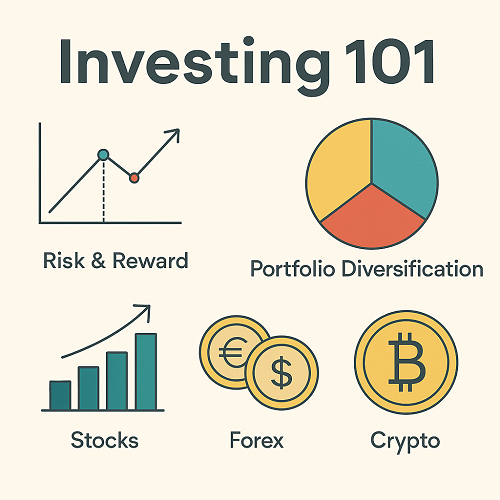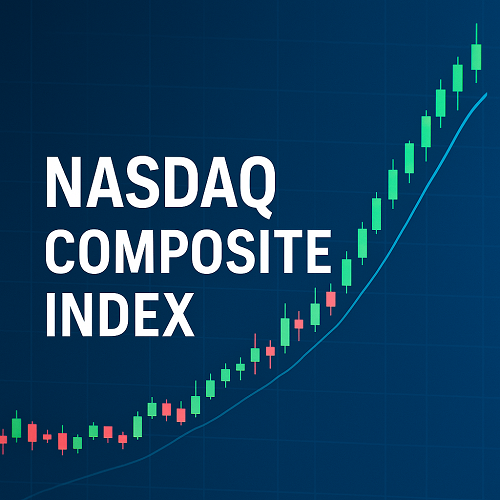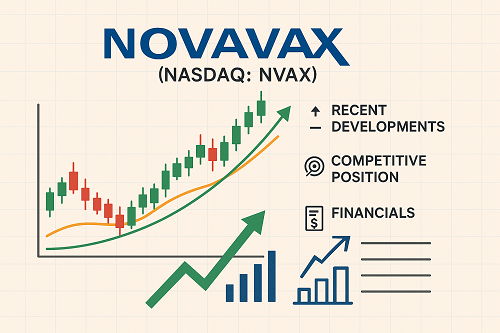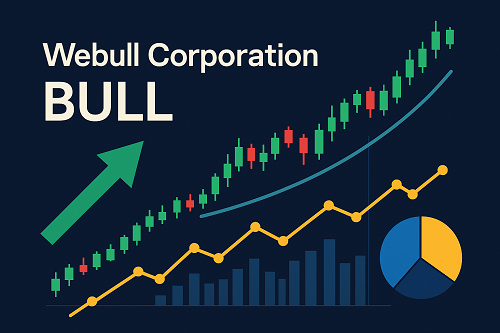What Is Investing — Definitions & Core Principles
Investing is the act of committing capital today in anticipation of greater future returns, accepting the possibility of loss. If you’re considering investing in stocks, it’s important to understand that unlike merely “saving,” investing presumes risk in exchange for upside potential.
The core pillars:
- Capital Allocation: Placing money into assets (stocks, bonds, crypto, real estate).
- Time Value & Compounding: A dollar invested today compounds over time.
- Risk / Reward Trade-off: Higher potential returns generally come with higher uncertainty.
- Diversification & Rebalancing: Spreading exposure to reduce idiosyncratic risk.
In contrast, trading involves attempting to profit from shorter-term market movements (days, hours), and speculation often refers to even higher-risk bets (e.g. options, derivatives) based more on directional calls than intrinsic valuations.
Investing vs Trading vs Speculation: Key Differences
| Dimension | Investing | Trading | Speculation |
|---|---|---|---|
| Time Horizon | Medium to long (months to decades) | Short to medium (days to weeks) | Very short (minutes, hours) |
| Focus | Fundamentals + macro + asset allocation | Price action, patterns, momentum | Big directional bets, leverage, volatility |
| Risk Management | Position sizing, diversification | Stop-loss, risk per trade limits | Often all-in or high leverage |
| Return Goal | Risk-adjusted steady growth | Beating short-term benchmarks | High upside, more volatile |
Traders must constantly manage execution, fees, slippage, psychology — a different mindset than long-term investors. Many serious investors use a hybrid: a “core” long-term portfolio plus a “satellite” active trading component.
Preliminaries: Personal Finance Health Check
Before you even pick a stock or open a crypto wallet:
- Eliminate high-interest debt — Credit cards, payday loans, personal lines — the interest drag often outweighs expected returns from investments.
- Emergency Fund — Aim for 3–12 months’ worth of living expenses in liquid, safe assets (cash, money market).
- Insurance & Protection — Life, disability, critical illness coverage if applicable.
- Define Goals & Time Horizons — Retirement, home purchase, children’s education, travel.
- Cash Flow & Budgeting Mastery — Track income, expenses, and ensure consistent surplus to invest.
Without these in place, even the sharpest investment strategy can be derailed by life’s shocks.
Understanding Risk, Time Horizon & Return Expectation
Risk Tolerance & Capacity
- Tolerance: how much volatility or drawdown you psychologically can endure.
- Capacity: how much loss you financially can afford (given your time horizon and goals).
A high-risk portfolio is meaningless if you’ll panic-sell at -20%.
Expected Return Models
- Equity premium models: equities tend to outperform risk-free rate by a few percentage points per year (historically 4–6%).
- Risk-free + Beta × Premium (CAPM): return = R_f + β * (R_m – R_f).
- Compound growth model: FV=PV×(1+r)nFV = PV \times (1 + r)^nFV=PV×(1+r)n.
- Accept that in any given year, returns may deviate significantly from the long-term average.
Asset Classes Overview
Equities / Stocks
Ownership in a company. Offers growth and dividend income. Volatile, but high upside over long periods.
Bonds & Fixed Income
Loans to governments or corporations. Produce regular coupon payments. Lower volatility but susceptible to interest rate risk and credit risk.
Real Estate & REITs
Direct property investments or real-estate-backed securities. Offers income (rent) and capital growth; subject to leverage, illiquidity, and market cycles.
Commodities
Physical goods: gold, oil, agriculture, etc. Act as inflation hedges and diversification. Often volatile and storage/carry costs matter.
Forex / Foreign Exchange
Trading pairs of currencies (e.g. EUR/USD). The largest financial market globally. Highly liquid, 24/5, and driven by macroeconomics.
Cryptocurrencies & Digital Assets
Decentralized, digital-first assets built on blockchain. Ultra-high risk, but high potential. Examples: Bitcoin (BTC), Ethereum (ETH), altcoins, DeFi tokens.
Portfolio Construction & Asset Allocation
Asset allocation is the most critical decision for long-term performance. Studies show it explains 60–90% of the variance of portfolio returns.
Strategic vs Tactical
- Strategic allocation: A long-term “set and forget” weight (e.g. 60% stocks, 20% bonds, 20% crypto).
- Tactical overlay: Minor shifts (+/– 5–10%) based on macro views or momentum.
Efficient Frontier & MPT
Plot portfolios by expected return vs risk. The efficient frontier consists of portfolios that maximize return for a given risk. Use mean-variance optimization — but beware of overfitting and unrealistic assumptions.
Diversification dimensions
- Across asset classes (stocks, bonds, crypto)
- Geographically (U.S., Canada, emerging markets)
- By sector / theme (tech, healthcare, energy)
- By factor exposure (momentum, size, value)
Correlation matters: aim for low or negative correlations to smooth volatility.
Stocks: Fundamental & Technical Analysis
Fundamental Analysis
Key metrics and frameworks:
- Valuation multiples:
- P/E (Price/Earnings)
- P/B (Price / Book)
- EV/EBITDA
- PEG ratio (P/E ÷ growth rate) - Discounted Cash Flow (DCF): project free cash flows and discount to present.
- Qualitative factors: competitive moats, management quality, brand, regulatory advantage.
- Growth vs Value: Growth stocks emphasize future earnings; value emphasizes low valuation and reliable fundamentals.
- Dividend investing: dividend yield, payout ratio, sustainability, dividend growth.
Technical / Price-Based Tools
- Trend lines, support/resistance zones
- Moving averages: SMA, EMA, and crossovers
- Momentum indicators: RSI, MACD, Stochastic
- Volume patterns & breakouts
- Candlestick patterns: doji, engulfing, hammer
- Chart patterns: head & shoulders, triangles, flags
Risk Controls & Position Sizing
- Use stop-loss orders (fixed or volatility-based).
- Risk per trade limit (e.g. 1–2% of capital).
- Scaling in/out (entering partial positions).
- Trailing stops to capture upside while protecting gains.
Forex Trading Essentials
FX Market Structure & Key Players
Participants: central banks, commercial banks, hedge funds, retail brokers, corporations.
Market is over-the-counter (OTC), decentralized, globally open 24 hours (Monday–Friday).
Currency Pair Types
- Major pairs: EUR/USD, USD/JPY, GBP/USD
- Minor / Cross pairs: EUR/GBP, AUD/JPY
- Exotic pairs: USD/TRY, USD/ZAR (low liquidity, high volatility)
Drivers of Exchange Rates
- Interest rate differentials (carry trade)
- Monetary policy & central bank statements
- Trade balances & capital flows
- Political risk & market sentiment
- Risk-on / risk-off global cycles
Leverage & Margin
Forex brokers often offer 50:1, 100:1, or even 500:1. While leverage magnifies gains, it also magnifies losses — the risk of ruin is high without discipline.
FX Strategy Examples
- Trend following: ride currency trends using moving averages or breakout systems
- Carry trade: long high-yielding currencies funded by shorting low-yield ones
- Range / mean-reversion: trade oscillations within channels
- News / event-driven: trade post-central bank decisions or economic surprises
Crypto Investing & Trading
Blockchain Basics & Token Types
Blockchains store decentralized ledgers. Cryptos may be:
- Coins (native to a chain, e.g., BTC, ETH)
- Tokens (built on a chain, e.g. ERC-20 on Ethereum)
- Utility tokens, governance tokens, security tokens
On-Chain Metrics & Fundamentals
- Active addresses, transaction volume, daily fees
- Network growth rates (new addresses)
- Tokenomics: supply schedule, inflation rate, staking yield
- Total Value Locked (TVL) in DeFi
- Developer activity, GitHub commits, ecosystem vitality
Crypto Valuation Frameworks
- Metcalfe’s Law: value ~ (users)²
- Network value to transactions ratio (NVT)
- Discounted cash flows of token fee revenues
- Shock model: adoption shocks + regulatory/regime changes
Trading Crypto
- Spot trading, margin / futures / perpetual contracts
- Swing trades (days to weeks), intraday scalping
- Yield farming / staking for passive returns
- Arbitrage across exchanges or across chain bridges
- Risk controls: circuit breakers, exchange collateral, wallet security
Risks in Crypto
- Volatility & drawdown risk
- Regulatory changes / legal crackdowns
- Counterparty risk (exchanges, lending platforms)
- Smart contract bugs / hacks
- Liquidity risk & slippage
The Psychology of Investing
Human nature is the hardest obstacle in markets.
- Anchoring: clinging to past prices
- Loss aversion: losses feel heavier than gains
- Overconfidence: overestimating your skill
- Herd mentality / FOMO
- Recency bias: overweighting recent trends
Solutions:
- Pre-define rules and stick to them
- Use checklists & decision frameworks
- Maintain a trading/investment journal
- Apply probabilistic thinking (“this may win 60% of time”)
- Review mistakes & internalize lessons
Fees, Costs & Tax Efficiency
Fees & Costs That Erode Returns
- Expense ratios (mutual funds / ETFs)
- Broker commissions (stock, crypto)
- Bid-ask spread (especially in FX / crypto)
- Slippage (price moved while order filled)
- Borrowing / leverage cost
- Custodial / withdrawal fees
Even a 1% annual drag can reduce long-term gains dramatically.
Tax Efficiency
- Capital gains rates vs income rates — varies by country
- Holding periods: short-term often taxed higher
- Crypto tax rules (many jurisdictions treat crypto as property)
- Tax-loss harvesting to offset gains
- Location optimization: holding assets in tax-advantaged accounts (IRA, TFSA, RRSP, etc.)
Rebalancing & Portfolio Maintenance
Why Rebalance?
With time, your portfolio drifts — equities may swell to 70% from original 60%, bonds shrink. Rebalancing resets risk profile.
Methods
- Calendar rebalancing (quarterly, annually)
- Threshold rebalancing (rebalance when allocation deviates by X%)
- Constant-mix rebalancing
- Tactical tilt adjustments (minor shifts based on views)
Dealing with Regime Changes
- Adapt to interest rate cycles, inflation, yield curve shifts
- Use macro overlays (e.g. rotate out of equities into inflation hedges)
- Maintain dry powder (cash) for opportunities
Performance Measurement & Risk Metrics
Return Metrics
- Absolute return, CAGR, vs benchmark (e.g. S&P 500)
- Excess return (alpha)
Risk & Sharpe-Type Ratios
- Sharpe Ratio = (Return − Risk-Free) / Std Dev
- Sortino Ratio (uses downside deviation)
- Max Drawdown, Calmar Ratio
- Value at Risk (VaR), Expected Shortfall (ES)
Attribution
Break down what contributed + detracted (by asset class, region, trade-level) — useful for refining strategy.
Real-World Example Portfolios
Suppose an investor has $100,000. Here are three model portfolios (for illustrative purposes):
| Style | Stocks | Bonds | Crypto / Digital | Cash / Alternatives |
|---|---|---|---|---|
| Conservative | 40% | 50% | 5% | 5% |
| Balanced | 60% | 25% | 10% | 5% |
| Aggressive | 80% | 10% | 8% | 2% |
Example holdings:
- Stocks: mix of stable large-cap, growth, and international.
- Bonds: government + corporate laddered.
- Crypto: BTC, ETH, and selective altcoins or DeFi bets.
- Cash: emergency reserves or tactical dry powder.
Backtest scenario: Over 10 years, the aggressive portfolio may outperform by 2% annually on average, but also endure deeper drawdowns of –40% in stress periods. The conservative might draw only –15% but have lower upside.
Stress-test across inflationary regimes, rate shocks, black swan events.
Common Mistakes & How to Avoid Them
- Chasing recent winners
- Overconcentrating (lack of diversification)
- Ignoring fees & slippage
- Failing to plan for risk
- Letting emotions override rules
- Over-leveraging
- Failing to adapt to macro regime changes
Avoid by methodical process, robust rules, and continuous review.
Trends & Macro Themes to Watch
- AI / Machine learning in finance
- Decentralized finance (DeFi), tokenization of real-world assets
- Central bank digital currencies (CBDCs)
- Climate finance, ESG investing
- Monetary regime changes, rising rates / inflation cycles
- Geopolitical fragmentation, supply chain realignment
These can shape opportunities and risks across stocks, FX, and crypto.
FAQ: Top Questions About Investing
Q: How much should I start with?
You can begin with small amounts — even $50–$100. The goal is consistency and habit.
Q: Can I mix trading and long-term investing?
Yes — many allocate a “core” to long-term strategies and a “satellite” to active trading.
Q: How often should I rebalance?
Quarterly or semi-annually is enough for most; more active investors may use threshold triggers.
Q: Is crypto too risky?
It is volatile and speculative. But prudent sizing and risk controls make it viable as a higher-risk allocation.
Q: What if I panic during a crash?
Prior planning matters. Use stop-losses, rules-based exits, and reminder of long-term goals — don’t decide impulsively.
Conclusion & Suggested Action Plan
- Self-assess your financial foundation (debt, emergency fund, risk capacity).
- Define goals & timeframes (short-term, medium, long-term).
- Choose a core asset allocation suited to your profile.
- Select instruments (ETFs, individual stocks, crypto, FX) consistent with your risk budget.
- Implement rules and risk controls (position sizing, stop-loss, rebalancing).
- Track performance & maintain discipline — journaling helps.
- Iterate and learn — each drawdown, success, and mistake is feedback.





 XAUT-USD
XAUT-USD  AMD
AMD  MARA
MARA  SHOP
SHOP  BULL
BULL  CL=F
CL=F